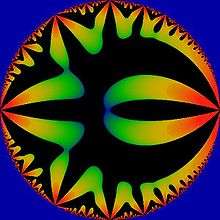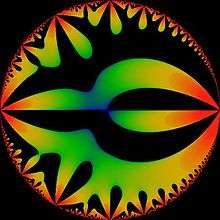Eisenstein series
- This article describes holomorphic Eisenstein series in dimension 1; for the non-holomorphic case see real analytic Eisenstein series and for the higher dimensional case see Siegel Eisenstein series
Eisenstein series, named after German mathematician Gotthold Eisenstein, are particular modular forms with infinite series expansions that may be written down directly. Originally defined for the modular group, Eisenstein series can be generalized in the theory of automorphic forms.
Eisenstein series for the modular group


Let τ be a complex number with strictly positive imaginary part. Define the holomorphic Eisenstein series G2k(τ) of weight 2k, where k ≥ 2 is an integer, by the following series:
This series absolutely converges to a holomorphic function of τ in the upper half-plane and its Fourier expansion given below shows that it extends to a holomorphic function at τ = i∞. It is a remarkable fact that the Eisenstein series is a modular form. Indeed, the key property is its SL(2, Z)-invariance. Explicitly if a, b, c, d ∈ Z and ad−bc = 1 then
If then so that is a bijection , i.e :
Overall, if then
and G2k is therefore a modular form of weight 2k. Note that it is important to assume that k ≥ 2, otherwise it would be illegitimate to change the order of summation, and the SL(2, Z)-invariance would not hold. In fact, there are no nontrivial modular forms of weight 2. Nevertheless, an analogue of the holomorphic Eisenstein series can be defined even for k = 1, although it would only be a quasimodular form.
Relation to modular invariants
The modular invariants g2 and g3 of an elliptic curve are given by the first two terms of the Eisenstein series as
The article on modular invariants provides expressions for these two functions in terms of theta functions.
Recurrence relation
Any holomorphic modular form for the modular group can be written as a polynomial in G4 and G6. Specifically, the higher order G2k's can be written in terms of G4 and G6 through a recurrence relation. Let dk =(2k+3)k!G2k+4. Then the dk satisfy the relation
for all n ≥ 0. Here, is the binomial coefficient and and .
The dk occur in the series expansion for the Weierstrass's elliptic functions:
Fourier series






Define . (Some older books define q to be the nome , but is now standard in number theory.) Then the Fourier series of the Eisenstein series is
where the coefficients c2k are given by
Here, Bn are the Bernoulli numbers, ζ(z) is Riemann's zeta function and σp(n) is the divisor sum function, the sum of the pth powers of the divisors of n. In particular, one has
The summation over q can be resummed as a Lambert series; that is, one has
for arbitrary complex |q| ≤ 1 and a. When working with the q-expansion of the Eisenstein series, this alternate notation is frequently introduced:
Identities involving Eisenstein series
As Theta functions
Given , let
and define,
where and are alternative notations for the Jacobi theta functions. Then,
thus,
an expression related to the modular discriminant,
Also, since and , this implies,
Products of Eisenstein series
Eisenstein series form the most explicit examples of modular forms for the full modular group SL(2, Z). Since the space of modular forms of weight 2k has dimension 1 for 2k = 4, 6, 8, 10, 14, different products of Eisenstein series having those weights have to be equal up to a scalar multiple. In fact, we obtain the identities:
Using the q-expansions of the Eisenstein series given above, they may be restated as identities involving the sums of powers of divisors:
hence
and similarly for the others. Perhaps, even more interestingly, the theta function of an eight-dimensional even unimodular lattice Γ is a modular form of weight 4 for the full modular group, which gives the following identities:
for the number rΓ(n) of vectors of the squared length 2n in the root lattice of the type E8.
Similar techniques involving holomorphic Eisenstein series twisted by a Dirichlet character produce formulas for the number of representations of a positive integer n as a sum of two, four, or eight squares in terms of the divisors of n.
Using the above recurrence relation, all higher E2k can be expressed as polynomials in E4 and E6. For example:
Many relationships between products of Eisenstein series can be written in an elegant way using Hankel determinants, e.g. Garvan's identity
where
is the modular discriminant.[1]
Ramanujan identities
Ramanujan gave several interesting identities between the first few Eisenstein series involving differentiation. Let
then
These identities, like the identities between the series, yield arithmetical convolution identities involving the sum-of-divisor function. Following Ramanujan, to put these identities in the simplest form it is necessary to extend the domain of σp(n) to include zero, by setting
- E.g.:
Then, for example
Other identities of this type, but not directly related to the preceding relations between L, M and N functions, have been proved by Ramanujan and Melfi, as for example
For a comprehensive list of convolution identities involving sum-of-divisors functions and related topics see
- S. Ramanujan, On certain arithmetical functions, pp 136-162, reprinted in Collected Papers, (1962), Chelsea, New York.
- Heng Huat Chan and Yau Lin Ong, On Eisenstein Series, (1999) Proceedings of the Amer. Math. Soc. 127(6) pp.1735-1744
- G. Melfi, On some modular identities, in Number Theory, Diophantine, Computational and Algebraic Aspects: Proceedings of the International Conference held in Eger, Hungary. Walter de Grutyer and Co. (1998), 371-382.
Generalizations
Automorphic forms generalize the idea of modular forms for general Lie groups; and Eisenstein series generalize in a similar fashion.
Defining OK to be the ring of integers of a totally real algebraic number field K, one then defines the Hilbert-Blumenthal modular group as PSL(2,OK). One can then associate an Eisenstein series to every cusp of the Hilbert-Blumenthal modular group.
References
- ↑ Milne, Steven C. (2000), Hankel Determinants of Eisenstein Series (PDF)
Further reading
- Naum Illyich Akhiezer, Elements of the Theory of Elliptic Functions, (1970) Moscow, translated into English as AMS Translations of Mathematical Monographs Volume 79 (1990) AMS, Rhode Island ISBN 0-8218-4532-2
- Tom M. Apostol, Modular Functions and Dirichlet Series in Number Theory, Second Edition (1990), Springer, New York ISBN 0-387-97127-0
- Henryk Iwaniec, Spectral Methods of Automorphic Forms, Second Edition, (2002) (Volume 53 in Graduate Studies in Mathematics), America Mathematical Society, Providence, RI ISBN 0-8218-3160-7 (See chapter 3)
- Serre, Jean-Pierre, A course in arithmetic. Translated from the French. Graduate Texts in Mathematics, No. 7. Springer-Verlag, New York-Heidelberg, 1973.